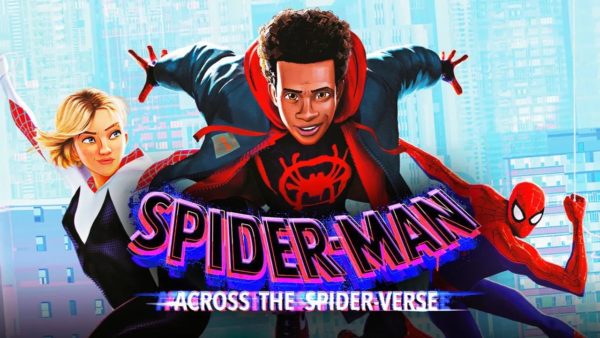
One of the year’s best films receives a stacked physical media release.
Now available on 4K, Blu and Digital, Spider-Man: Across The Spider-Verse (read my original review) is loaded with 90 minutes of bonus features, in addition to an audio commentary with the three directors (Joaquim Dos Santos, Kemp Powers, and Justin K. Thompson) and writers/executive producers Phil Lord and Christopher Miller (unfortunately without subtitles).
The featurettes are where the features shine:
Creating the Ultimate Spider-Man Movie is a broad catch-all featurette, where nearly every major creative and cast member discusses how the sequel to the 2018 hit came together to break new ground. Everyone understood that they couldn’t make the same movie again (the mandate was “more”…more of everything).
Most of the team approached this with the intent to make a great Spider-Man film, not a great animated film, an intriguing distinction that embodies Guillermo del Toro‘s philosophy about the form (he gets name-dropped).
This featurette has some fun behind the scenes footage of the animators filming themselves to get a sense of what the movement looks like before animation (much of it was improv and experimentation, which kept it “fresh and exciting.”).
There’s also praise for the diversity of the creative team (including Danielle Perez‘s differently abled Sun Spider), which is treated as a reflection of the real world and how collaboration and community contribute to the film’s success.
- Fun fact: several people mention that the production wound up involving more than 1K people, including 800 FX people!
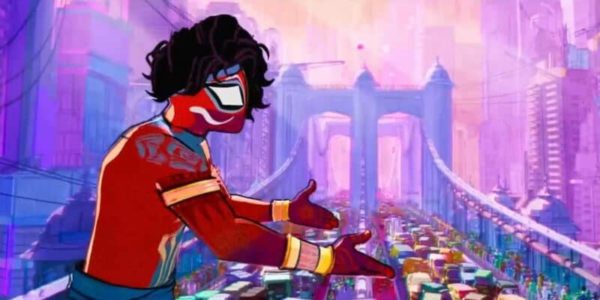
Across the Worlds: Designing New Worlds
There is some repetition from the Creating the Ultimate Spider-Man Movie featurette above, albeit with more of a focus on the five different Spider-Verses, which were each designed with their distinct visual and philosophical look.
Gwen’s World:
- Designed with a “drippy paint” look in cyan, orange and violet primary colours
- In this world, colour doesn’t respect the boundaries of objects.
- As I noted in my review, the environment changes around Gwen like a mood ring.
- Since Gwen lives in Manhattan, the production opted to use the Guggenheim as a recognizable landscape; its newness also juxtaposes with the old Renaissance look of the Vulture (voiced by Jorma Taccone)
Mumbattan:
- The goal was to capture the “busyness and grandeur” of Manhattan with the even more busy grandeur of Mumbai. “Endless chasm of city” – city made in gulch of empty Hudson, goes on forever (NY on top of itself 3 times).
- There are at least 4 different languages captured in these sequences and the visual look – offset printing imperfection, brushy ink work – was inspired by the vintage comics of Amar Chitra Katha.
2099:
- The world of Miguel O’Hara embodies the distinct look of futurists of the 70s and 80s with an old guard vibe. It’s a combination of the very clean look of Latin America architect Burle Marx and Space 1999.
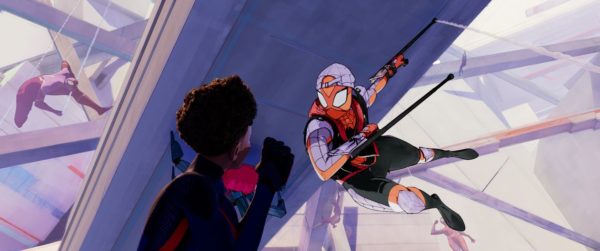
Obscure Spiders and Easter Eggs
Not too much substance here, so much as highlighting the staggering number of Spider-People and easter eggs referenced in the film. This includes:
- Tags and area codes through film, background characters modelled on crew
- 11 year old Preston Mutanga’s LEGO sequence
- References to The Mitchells vs The Machines and Cloudy with a Chance of Meatballs, and a prominent spot for the bagel from The Daniels’ Everything, Everywhere, All At Once
- Finally, the Onomatopoeia of Pavitr’s web-slinging in the Mumbattan sequence is translated into Indian dialects
“Imma do my own thing”: Interdimensional Destiny
This featurette is all about the central dilemma and maturation of Miles Morales (voiced by Shameik Moore), namely his refusal to live by the canonical comic rule of destiny or shut off his emotions like adversary Miguel O’Hara (voiced by Oscar Isaac).
Most of this content is embodied within the narrative of the film, though there is a tease that the third and final film will focus on the complications of the cliffhanger and Miles’ involvement in Dimension 42 – the world without a Spider-Man that he created by accident.
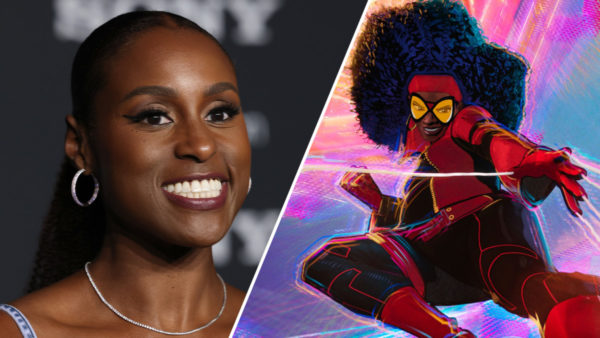
Your Friendly Neighbourhood Spider-cast
This featurette is unofficially divided in two: one part focuses on the returning voice cast, the other on the newbies.
The vibe among the returning actors is that they feel like family and “have literally become those characters; they have lived them.”
Fun facts:
- Jake Johnson (who voices Peter B. Parker) was great at ad-libbing (“he was comedy gold”) while Jason Schwartzman’s vocal performance was “an odyssey” (start with comedy and then wind up in very dark places).
- Issa Rae is credited with stealing ever scene she’s in
- Oscar Isaac’s presence is in his voice. Despite the character’s description as a “not funny Spider-Man”, there’s plenty of humour in how serioues Miguel is
- They wanted Daniel Kaluuya (who voices Hobie Brown) for his real life authentic (often rarely used) Camden accent
- While the actors elevated the characters when they got into the recording booth, a lot of credit is given to the three directors for letting them experiment and play
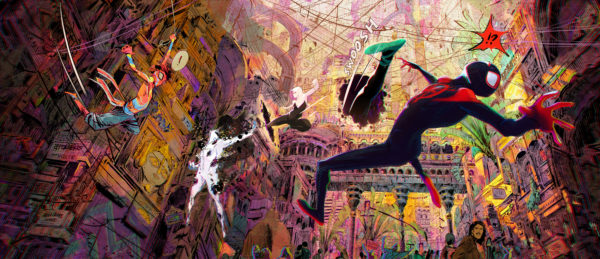
Spiders and Spots
This featurette is all about the different variations of Spider-People, as well as the film’s central antagonist, The Spot.
Fun Facts:
- There were 105 designs to get to Miles’ new suit
- Very little was done to change Gwen (voiced by Hailee Steinfeld), aside from making her shoes a little grungy like the comics
- Spot is described as a “comedian character” and the animators drew inspiration from waves and interference patterns. One of their main challenges: cracking how to incorporate the ever-changing black spots into the character’s speaking performance.
- Hobie Brown filled the team with excitement and dread because the character has such a dynamic look. They elected to incorporate as much (afro) punk they could, including the character’s iconic photocopied punk poster look, which embodies his rebellious aesthetic
- Pavitr (voiced by Karan Soni) is the definition of carefree teenage arrogance. His look changed several times to reflect his cultural identity (including the hiring of a whole Indian writer’s room). His hair is influenced by Indian gods, his spider logo is derived from scriptures, and he moves in traditional Indian martial art poses.
- Jessica Drew is described as 70s era – she’s luxe. Stylish. A vibe. One amusing point is that she’s the only character who wears make-up.
- Finally, it took 14 months to nail the final design for Miguel. Much is made of his “very graphic face mask” and the markings on his costume are those of an Aztec warrior.
Raising a Hero
Despite its length, this is arguably the most obvious of the featurettes, which focuses on the importance of family. It focuses on Peter B. Parker’s new status as a dad, Gwen’s struggle with her father (voiced by Shea Whigham) and Miles’ difficulty to lying to his parents Jeff (voiced by Brian Tyree Henry) and Rio (voiced by Lauren Vélez). Again, pretty standard stuff if you’ve seen the film.
Scratches, Score and the Music of the Multiverse
This is a featurette that could have been longer. It’s also unofficially divided in two: one of composer Daniel Pemberton’s “energetic” out of the box score that aims to distinguish itself from familiar action spectacles, as well as a briefer section on Metro Boomin’s soundtrack, which aims to bridge the new with the old-school.
Across the Comicsverse
For those with a cursory knowledge of all of the disparate comic influences for all of the Spider-People, this is the best featurette of the bunch. It highlights the contributions of the real world comic creators who consulted or contributed to the film, including:
- Kris Anka, character designer: he did most of the costume work.
- Rick Leonardi, whose work was instrumental for creating Miguel O’Hara’s 2099. He jokes that his short inking feathering technique is easy on paper, but hard for the animators to turn into 3D.
- Dan Slott worked on story process for the multi-verse plot, including cracking Miles’ connection to Dimension 42. Slott gets a great line when he explains that his “job is to torture Spider-Man”, ie: put all of that emotional weight on Spider-Man’s back.
- Brian Stelfreeze fashion illustration background proved essential in cracking the look of Jessica Drew. He praises the team for letting him “paint on paper, not digital” in order to push the character (and her pregnancy) to the foreground.
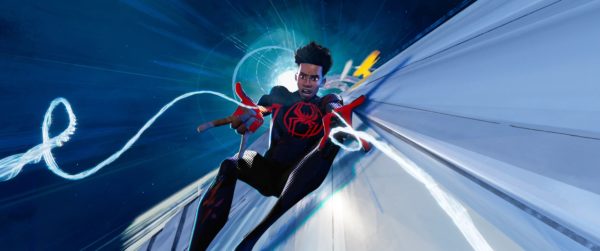
Escape from Spider-Society
This is a solid featurette on arguably the film’s most buzzy action set-piece: Miles’ 5 minute chase scene from 200-300 Spider-People in the “Brutalist jungle gym with no up or down” head quarters of the Spider-verse.
Fun Facts:
- Lord and Miller pitched this as the most expensive set piece they could write and bemoan that it’s a “fun idea that’s really hard to execute.” It took 2 years to come together.
- The sequence is described as a celebration of all of the Spider styles, though the team explains that it was daunting to try to know all of the different histories.
- They also made specific efforts to include more women and body diversity.
- One major challenge: how to balance the colour palette and animation style? Apparently it involved varying the reds and blues, as well as light and dark.
- Additional headaches: how to ensure that the chase wasn’t merely noise, but had levels to it to keep audiences invested.
- Surprisingly an early cut of the film didn’t include Peter B. Parker pausing mid-chase to explain himself to Miles. The sequence didn’t work, but it wasn’t until this scene was put in that they understood why; Across the Spider-Verse needed that emotional moment to bring the narrative back to family.
- One key character moment is all about the eyelines: when Miles is fighting Miguel on the vertical train, the teen is shot exclusively from above and his eyeline is always off-centre so he looks small and insecure. He rises into frame and look directly into the camera as the fight progresses, culminating in a hero moment when he rises into frame after kicking O’Hara off.
Spider-Man: Across the Spider-Verse is now available on Digital and Physical media.